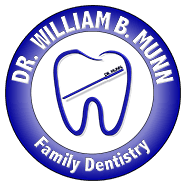Dental bridges have saved countless patients from the embarrassment and discomfort of gaps between the teeth. If you have a missing tooth or are facing tooth extraction, dental bridges should be one of the replacement options you consider with Dr. William Munn. Fixed into place and supported by the adjacent teeth, bridges restore the look and feel of a complete, healthy smile. A well-designed and well cared-for bridge can last for years!

What Is a Dental Bridge?
As the name implies, the restorations “bridge” the space created by one or more missing or extracted tooth. Bridges are carefully designed to resemble the shape, size and appearance of natural teeth. A quality bridge should blend seamlessly with the surrounding teeth.
Our practice offers several different types of bridges. The type of bridge most appropriate for your case will depend on the location of the gap in your mouth, the number of available supporting teeth and other factors.
Traditional bridges consist of an artificial tooth, called a pontic, held in place on both sides by crowns. The crowns fit over the adjacent or “abutment” teeth, and the pontic fits snugly into the space.
Cantilever bridges are somewhat like traditional bridges, except they are used when there are natural abutment teeth on only one side of the gap.
Maryland bridges have a pontic supported by a porcelain or metal framework. The pontic fits into the gap, and the framework, which resembles wings, is attached to the backsides of the adjacent teeth.
The fourth type of bridges are implant-retained bridges. Often used to replace back teeth, implant-retained teeth are supported by dental implant posts instead of natural teeth. They are extremely stable and secure in the mouth, and can replace at least three missing teeth in a row.
Dental Bridge Placement Process
Like dental crowns and veneers, bridges usually require at least two dental visits to prepare, fit and place.

During your first visit, Dr. Munn will prepare the abutment teeth by removing a small amount of tooth structure and shaping the teeth to receive the crowns. Once the teeth have been prepared, he will take impressions of the area and send the information to the lab that creates your custom bridge.
A temporary bridge is placed over the prepared teeth and gap. You will wear the temporary bridge until your permanent restoration is ready.
Once your custom bridge is ready, Dr. Munn will remove the temporary bridge and try the new one on in your mouth. He can make adjustments on the spot to improve the fit or feel of the bridge. When you are happy, he will bond it into place.
Implant-retained bridges require some extra steps: the implant posts must be placed in the jawbone with an oral surgery procedure. They require additional time to heal before the bridge can be permanently placed.
After placing your bridge, Dr. Munn and our team will provide you with instructions for keeping it clean and intact. We recommend seeing us every six months for a dental checkup.
Learn More about Dental Bridges
Would you like to explore the possibility of replacing a missing tooth with a dental bridge? Dr. William Munn is here for you. He will evaluate your needs on an individual basis and recommend the option that makes the most sense. Request a consultation with him to learn more.



